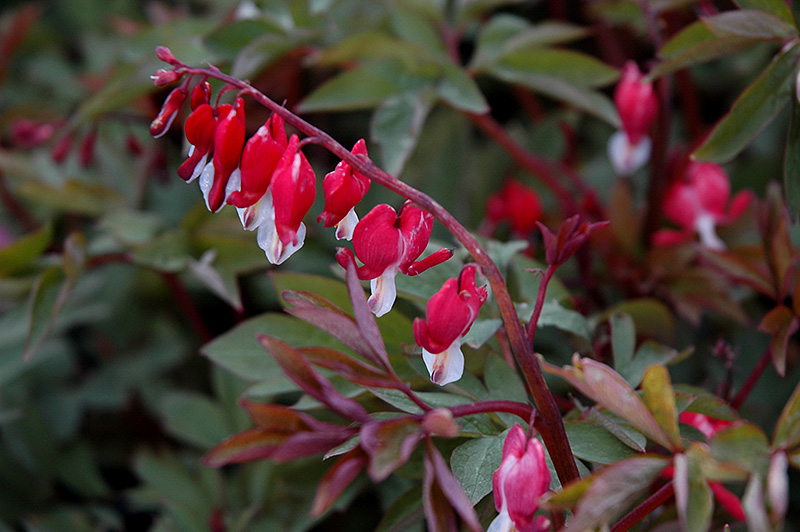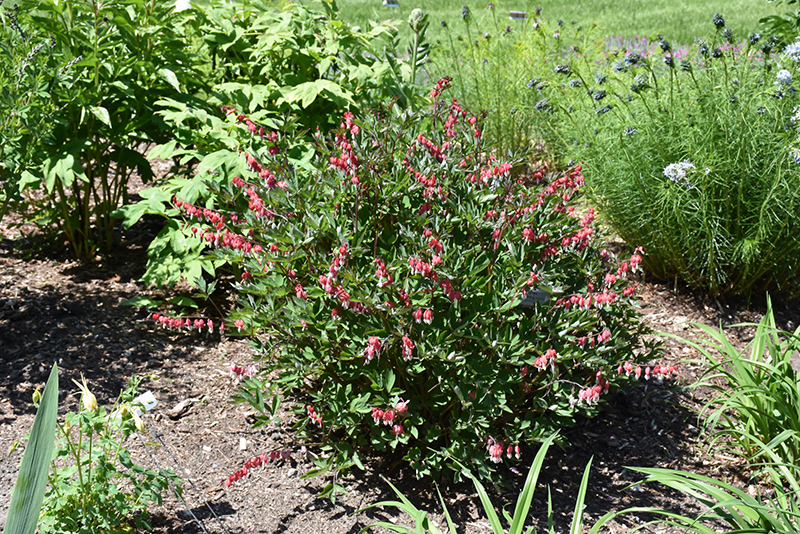Valentine Bleeding Heart
Dicentra spectabilis 'Hordival'
Height: 30 inches
Spacing: 24 inches
Sunlight:
![]()
![]()
Hardiness Zone: 2
Other Names: Old Fashioned Bleeding Heart
Description:
Puffy, heart-shaped flowers are bright red with a white lip bloom late spring. Red stems. Powdery green foliage. Part to full shade. Deer resistant. Attracts hummingbirds. Use for borders and containers, and as cut flower.
Ornamental Features
Valentine Bleeding Heart features delicate nodding cherry red heart-shaped flowers with white centers dangling from the stems from late spring to early summer. The flowers are excellent for cutting. Its ferny compound leaves remain grayish green in color throughout the season.
Landscape Attributes
Valentine Bleeding Heart is an herbaceous perennial with a mounded form. Its relatively fine texture sets it apart from other garden plants with less refined foliage.
This plant will require occasional maintenance and upkeep, and should be cut back in late fall in preparation for winter. It is a good choice for attracting butterflies and hummingbirds to your yard, but is not particularly attractive to deer who tend to leave it alone in favor of tastier treats. It has no significant negative characteristics.
Valentine Bleeding Heart is recommended for the following landscape applications;
- Shade
- Mass Planting
- Rock/Alpine Gardens
- Border Edging
- General Garden Use
- Container Planting
Planting & Growing
Valentine Bleeding Heart will grow to be about 30 inches tall at maturity, with a spread of 28 inches. When grown in masses or used as a bedding plant, individual plants should be spaced approximately 24 inches apart. It grows at a medium rate, and under ideal conditions can be expected to live for approximately 15 years. As an herbaceous perennial, this plant will usually die back to the crown each winter, and will regrow from the base each spring. Be careful not to disturb the crown in late winter when it may not be readily seen! As this plant tends to go dormant in summer, it is best interplanted with late-season bloomers to hide the dying foliage.
This plant does best in partial shade to full shade. Keep it well away from hot, dry locations that receive direct afternoon sun or which get reflected sunlight, such as against the south side of a white wall. It prefers to grow in average to moist conditions, and shouldn't be allowed to dry out. It may require supplemental watering during periods of drought or extended heat. It is not particular as to soil pH, but grows best in rich soils. It is somewhat tolerant of urban pollution. Consider applying a thick mulch around the root zone in both summer and winter to conserve soil moisture and protect it in exposed locations or colder microclimates. This is a selected variety of a species not originally from North America. It can be propagated by division; however, as a cultivated variety, be aware that it may be subject to certain restrictions or prohibitions on propagation.
Valentine Bleeding Heart is a fine choice for the garden, but it is also a good selection for planting in outdoor pots and containers. It can be used either as 'filler' or as a 'thriller' in the 'spiller-thriller-filler' container combination, depending on the height and form of the other plants used in the container planting. It is even sizeable enough that it can be grown alone in a suitable container. Note that when growing plants in outdoor containers and baskets, they may require more frequent waterings than they would in the yard or garden.


